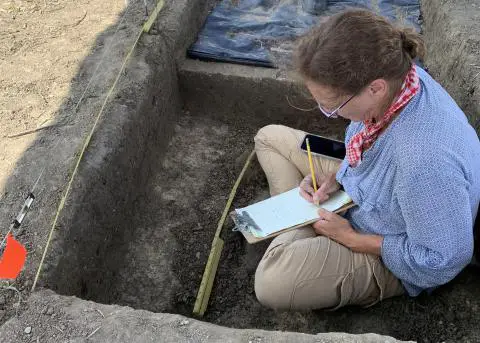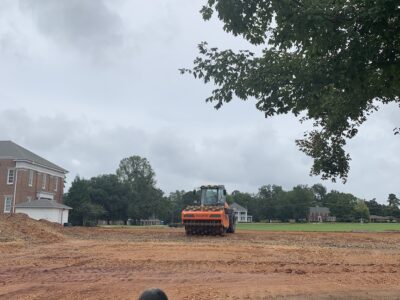
Gov. Kay Ivey announced the expansion of Alabama Highway 69 through Hale and Marengo Counties within only a few weeks of another announcement of massive significance for the Black Belt: the discovery of evidence of the lost city of Mabila. The city was a part of the chiefdom of Chief Tuskaloosa, the legendary Muskogean chief who led a resistance against the forces of Spanish conquistador Hernando DeSoto—within the city’s walls.
University of West Alabama professor, and former Greensboro resident, Dr. Ashley Dumas, announced late last year that her team had found evidence of the location of the battle, long disputed by historians, somewhere in the area of north Marengo County near the border with Hale.
The Battle of Mabila was one of the bloodiest ever fought on North American soil, and spelled the beginning of the end of DeSoto’s expedition through Alabama—a time marked, up to that point, by unchecked pillaging of the Native Americans living there, killing and taking slaves from the towns as they went. The Spanish took Tuskaloosa prisoner in the town of Atahatchee—which local lore says was in east Perry County—and carried him as a captive to Mabila, a town under his control where he promised to refresh the conquistadors with food, supplies, women, and slaves.
Instead, Tuskaloosa had laid a trap. DeSoto’s men found Mabila populated almost entirely with men of fighting age, and once the Spanish were within the city’s walls, a battle broke out that left most of the Native American forces dead, Tuskaloosa himself never heard from again, and the Spanish expedition’s supplies exhausted or destroyed. While they had the advantage of steel and armor, DeSoto’s force as well took heavy battlefield casualties from which it never recovered.
It is the story of an unstoppable force meeting an immovable object—and maybe a metaphor for the intersection of the planned highway expansion and the hunt for the centuries-lost city.
“Based on the map of the route that I’ve seen, it does appear that some of the sites we identify as being in the Mabila chiefdom may be impacted,” said Dumas in an email interview this week. Her team has discovered Spanish artifacts in the area that match the time period of DeSoto’s expedition, lending credence to local tradition that Mabila was in the western Black Belt. Dumas said she had some concerns that the speed with which the Highway 69 project is being undertaken could lead to the loss of archaeologically-significant sites: “Building a highway won’t be stopped by the presence of an archaeological site, so why not take a little more time and money to study what will be destroyed?”
Every site is a unique and irreplaceable part of Alabama history. And now, we stand to lose dozens of them and all the knowledge they can provide because someone is in a hurry.”
— Dr. Ashley Dumas
The Highway 69 project is being funded, Alabama Dept. of Transportation says, entirely by the newly-implemented state gas tax program, a key piece of Gov. Ivey’s first term in office. If the project were being funded, even partially, with federal money, it would require the direct involvement of the descendants of the people who lived here in Tuskaloosa’s time: representatives of the Choctaw, Alabama-Coushatta, and Creek Nations.
The Tribes, Dumas said, are aware of both the archaeological work and the planned highway construction. “The Choctaw Nation of Oklahoma is aware of the potential impact and may already have contacted other potentially interested tribes.”
By funding the project entirely with state dollars, Dumas said, ALDOT would be able to circumvent much of the federal regulatory and oversight framework that could slow the project—but also protect key cultural assets in the region.
“The public and legislators don’t know that those regulations are some of the most fair and efficient laws in the U.S., and they are among only a handful that protect our nation’s rich natural environment and history,” she said.
ALDOT: State performing its own analysis of impacts
Alabama Dept. of Transportation representative Stan Biddick answered questions about the matter on behalf of the agency. Though the project will not be subject to federal oversight, he said, ALDOT will be taking measures to gauge the construction’s historical impact. He said his agency, and head State Archaeologist Stacey Hathorn, had been in contact with the team at Mabila.
“We are performing Cultural Resources analysis for the project currently. These duties include reviews of known historic structures, analysis structures for potential eligibility, and archeology testing within the proposed Rights-of-Way. As part of the Cultural Resources process, the Department coordinates with AL State Historic Preservation Office and Native American Tribes,” said Biddick. He described the state’s process: “During the archelogy testing, the Department uses a three phased approach approved by Federal Agencies, State Agencies and Tribes on all projects. Phase I is initial look by performing shovel testing. If nothing is found and the groups agree with our procedures and documentation, then no additional work is performed. Phase II is done if there are some findings in the Phase I and we complete further investigations to more define the area and artifacts. At the end of Phase II testing all the group evaluates the findings and procedures again. If there are findings that call for movement into Phase III, the Department would conduct an archeological dig and potentially recover/document the findings for preservation. Depending on the findings in any of the Phases could potentially cause a shift in the alignment. This same process is used once the project is under construction and something is found. The construction in the area would cease and the groups would evaluate what was disturbed to determine the amount of work that would be completed at the site before construction could resume work.”
Without formal Federal or Tribal oversight, however, it is unclear whether the state’s process will be as effective, or thorough, as it would have been with it.
There is one possibility Dumas mentioned that could still bring the project under the Federal purview: it includes multiple major stream crossings. These undertakings often require federal permits from the U.S. Army Corps of Engineers.
If that is the case, Dumas said, “I hope that the Corps will declare the entire project to be a single undertaking. If they do, then it will be necessary to look for archaeological sites within the length of the entire right-of-way. However, I don’t know who is making those decisions and how they make them.”
With the first stages of construction slated to begin later this year, though, Dumas said the apparent rush to see the project completed—which is planned for 2027—could mean invaluable losses. She questioned the priorities behind the construction, and its potential impact on the Black Belt region.
“Personally, I regret that the project seems geared toward satisfying those who can afford weekends with Bama or at the beach while bypassing many in the Black Belt who cannot. Plus, it has always just been a really pretty drive,” she said.
If, in the rush to begin construction, state leaders lose sight of the potential impact, she said, the losses that could follow will not be soon repaired: “Every site is a unique and irreplaceable part of Alabama history. And now, we stand to lose dozens of them and all the knowledge they can provide because someone is in a hurry.”




